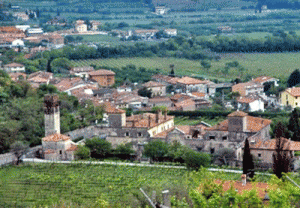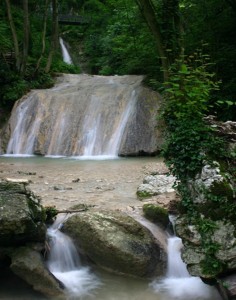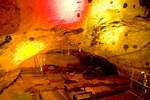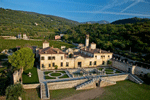The territory of Fumane lies in the heart of the Valpolicella,
 constituted by the incised valley “dei Progni”, by the plain of the valley floor and by the Lessini mountains, into which four villages have grown: Mazzurega, Cavalo, Breonio and Molina. The landscape is therefore diversified, offering the sweetness of the vineyards in the valley, the stretches of cherry tree fields on the hills and the impressive waterfalls and the woods of the
constituted by the incised valley “dei Progni”, by the plain of the valley floor and by the Lessini mountains, into which four villages have grown: Mazzurega, Cavalo, Breonio and Molina. The landscape is therefore diversified, offering the sweetness of the vineyards in the valley, the stretches of cherry tree fields on the hills and the impressive waterfalls and the woods of the  mountainous area to the north. The valley is overlooked by Mount Pastello, with its red-veined marble, an area where a valuable flora and many species of butterflies can still be found. Places that cannot be missed include the invaluable nature of the Park at the Molina Waterfalls and of the paths among the torrents, part of the Regional Natural Park of Lessinia. The landscape heritage is enriched by the traces that history has left since 80.000 years ago.
mountainous area to the north. The valley is overlooked by Mount Pastello, with its red-veined marble, an area where a valuable flora and many species of butterflies can still be found. Places that cannot be missed include the invaluable nature of the Park at the Molina Waterfalls and of the paths among the torrents, part of the Regional Natural Park of Lessinia. The landscape heritage is enriched by the traces that history has left since 80.000 years ago. Other places to visit are the “Grotta di Fumane“, a very important archeological site that is still operating and is now used as a museum, the medieval churches, the rural courtyards, the villages entirely built with Molina and Gorgusello stone, and the wonderful villas of the XV century; especially famous is Villa Della Torre. A destination of high religious interest is the shrine dedicate to Our Lady of La Salette, especially dear to the farmers of the valley, whose vineyards were protected from disease. Fumane is, in fact, one of the centres of production of wine which, together with oil and stone, contribute to the international fame of the valley.
Other places to visit are the “Grotta di Fumane“, a very important archeological site that is still operating and is now used as a museum, the medieval churches, the rural courtyards, the villages entirely built with Molina and Gorgusello stone, and the wonderful villas of the XV century; especially famous is Villa Della Torre. A destination of high religious interest is the shrine dedicate to Our Lady of La Salette, especially dear to the farmers of the valley, whose vineyards were protected from disease. Fumane is, in fact, one of the centres of production of wine which, together with oil and stone, contribute to the international fame of the valley. CHURCHES AND VILLAS OF FUMANE: after being immersed in the rich nature of the place is of great interest to wander around the villages to discover the many districts, medieval churches scattered throughout the territory, the courts rustic; villages built entirely of stone like Molina and Gorgusello and the splendid fifteenth-century villas, such as the famous Villa Della Torre certainly offer many ideas. Another place of great religious interest is the Shrine of Our Lady of La Salette, so dear to the farmers of the valley for protecting the vineyards from the disease.
CHURCHES AND VILLAS OF FUMANE: after being immersed in the rich nature of the place is of great interest to wander around the villages to discover the many districts, medieval churches scattered throughout the territory, the courts rustic; villages built entirely of stone like Molina and Gorgusello and the splendid fifteenth-century villas, such as the famous Villa Della Torre certainly offer many ideas. Another place of great religious interest is the Shrine of Our Lady of La Salette, so dear to the farmers of the valley for protecting the vineyards from the disease.
WINES AND TYPICAL FOOD OF FUMANE: Fumane is one of the centers of production of Valpolicella wines that, together with the oil and stone, give the valley an international reputation. The typical cuisine of Valpolicella comes from the products of the land or pasture and followed the seasons; for the greater were the vegetables with the minestrone soup or broth enriched with bread and olive oil, cheeses, homemade pasta noodles, noodles, lasagne, gnocchi, and certainly I read, beef, chicken, tongue, and peverada accompanied by sausage, green sauce and horseradish. A valuable product of the area is then the black truffle.
TERRITORY OF FUMANE
Fractions: Breonio, Cavalo, Mazzurega, Molina
Surrounding municipalities: Dolce’, Marano Valpolicella, San Pietro in Cariano, Sant’Ambrogio di Valpolicella, Sant’Anna d’Alfaedo
The three valleys of the Valpolicella this is the deepest since dug in the limestone karst of the Jurassic Vaio Gravasso to the surface of Breonio. The streams that wind between these steep slopes of woods and rocks have formed several impressive waterfalls. The northern area, the bottom of which flows the river Progno, is called “Valley of Progni.” The Fumane valley, the westernmost of the valleys Lessiniche, is divided by the Adige Valley from the ridge of the batter and Pastel and eroded, on the west side, from Pastomie. Monte Pastello, with its red veins of marble, enjoys great natural interest for the presence of rare species of flora and variety of butterflies and insects.
The hills that border the valley sides, divide east from Marano valley and to the west by the valleys of Gargagnago and Sant’Ambrogio. The area north of Fumane becomes part of the plateau of Lessini and many areas are part of the Regional Natural Park of Lessinia, the town is bordered on the east by the municipality of Marano, north with that of Sant’ Anna D’Alfaedo, west with the municipalities of Dolcè and Sant’Ambrogio, to the south with the municipality of San Pietro in Cariano and even Sant’Ambrogio.
HISTORY OF FUMANE
In Roman times, the primitive population of Arusnati leaves clear traces of their cults in gravestones and inscriptions, most of which are now preserved in the Museum of Lapidary Maffeiano Verona. Just at that time was the center of Fumane “Pagus Arusnatium”, the administrative district that made people independent and stretched across the Valpolicella. The importance of this area is also evidenced by the remains of the Roman defensive work, erected towards the summit of Mount Pastel.
Date back to the time several churches and municipal documents, which among other things would go back to these lands the origin of the Montague family of Verona, related to the famous story of Romeo and Juliet
During the High Middle Ages, that leaves few traces, the Lombards dominate Fumane, then known as “Val de sala”, a name of Lombard origin. Date back to the Middle Ages several monumental presences, such as the fourteenth-century church of San Zeno in Fumane or the palace of Federico della Scala, Count della Valpolicella, then reconstructed monumental villa in the sixteenth century by the Della Torre.
The cult of the villa is in vogue even in this valley between the fifteenth and sixteenth centuries, and there are numerous villas that testify to this phenomenon. In the period after the Second World War were born here the small and medium industry and all activities related to the service sector. The population is growing but will remain scarce and unevenly distributed on the large territory.
